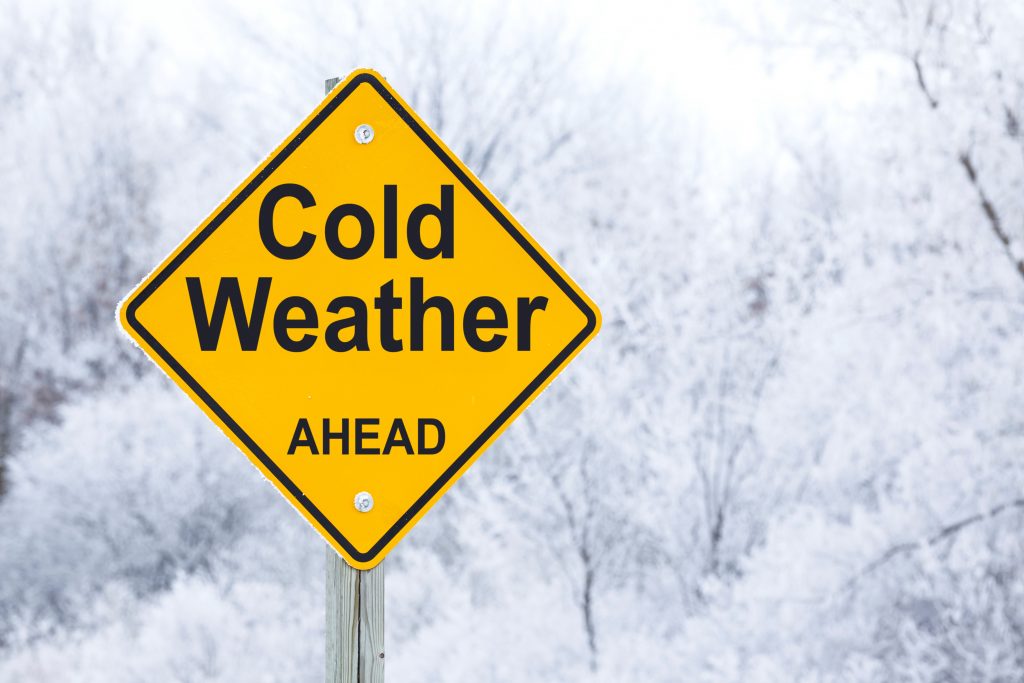As you all know the very frigid temperatures are coming within the next few days! Prolonged exposure to low temperatures, wind and/or moisture can result in cold-related injury from frostbite and hypothermia. Here are some suggestions on how to keep warm and avoid frostbite and hypothermia. You do not plan for injuries or frostbite, so if something unfortunate happens and you are exposed to the cold elements (I.E. car breakdown, roadblock, road shutdown, car wreck, etc.) make sure you are prepared in every way possible.

Dress properly
- Wear several layers of loose-fitting clothing to insulate your body by trapping warm, dry air inside. Loosely woven cotton and wool clothes best trap air and resist dampness.
- The head and neck lose heat faster than any other part of the body. Your cheeks, ears and nose are the most prone to frostbite. Wear a hat, scarf and turtleneck sweater to protect these areas.
- Wear warm socks, insulated gloves and snow boots if possible
Frostbite: What to look for
- The extent of frostbite is difficult to judge until hours after thawing. There are two classifications of frostbite:
- Superficial frostbite is characterized by white, waxy or grayish-yellow patches on the affected areas. The skin feels cold and numb. The skin surface feels stiff and underlying tissue feels soft when depressed.
- Deep frostbite is characterized by waxy and pale skin. The affected parts feel cold, hard, and solid and cannot be depressed. Large blisters may appear after re-warming.
What to do
- Get the victim out of the cold and to a warm place immediately.
- Remove any constrictive clothing items that could impair circulation.
- If you notice signs of frostbite, seek medical attention immediately.
- Place dry, sterile gauze between toes and fingers to absorb moisture and to keep them from sticking together.
- Slightly elevate the affected part to reduce pain and swelling.
- If you are more than one hour from a medical facility and you have warm water, place the frostbitten part in the water (102 to 106 degrees Fahrenheit). If you do not have a thermometer, test the water first to see if it is warm, not hot. Re-warming usually takes 20 to 40 minutes or until tissues soften.
- What not to do
- Do not use water hotter than 106 degrees Fahrenheit.
- Do not use water colder than 100 degrees Fahrenheit since it will not thaw frostbite quickly enough.
- Do not rub or massage the frostbite area.
- Do not rub with ice or snow.
If Your Car Breaks Down in Winter
Remember these tips so you can act wisely in case of emergency. 7 Tips to help you survive in freezing temperatures.
Car breakdown?
- If you’re stranded in a car and can’t drive further, don’t get out. Call for help if your car broke down. Run the engine occasionally for warmth but keep a window Be sure the exhaust pipe isn’t blocked by snow.
Run out of gas?
- f the car runs out of gas, keep all the windows shut. Stay on the lookout for help. Make sure your windows are cleared of snow so passing drivers can see that there’s someone in the car.
Stuck for a while?
- Exercise or move your arms and legs for warmth and keep yourself awake. Don’t go to sleep under any circumstances
Caught outside?
- f you’re caught outside while on foot, head to the nearest shelter. Tie a scarf over your nose and mouth to protect your ears and face and to prevent suffocation from the wind and snow.
Stuck in a snowbank?
- If your vehicle is really stuck, don’t wear yourself out shoveling it out, according to the News Wheel. Instead, save your energy and concentrate on staying warm.
Ice scraper breaks?
- Prepare for a broken ice scraper ahead of time by making sure to include a back-up scraper and brush in your vehicle. Even better, also invest in a windshield protector that will make de-icing much easier.
Getting thirsty?
- The last thing you want to do when you’re stranded is eat snow directly, according to the News Wheel. The energy your body expends warming up the snow makes it harder for you to retain body heat. If you happen to have an empty container, though, you can place snow inside of it and drink it after it melts.
We know you can work out in the elements, but for how long?
- Take breaks in shelters, away from the wind and cold
- Drink warm liquids slowly
- Make sure your clothes are dry. Take a change of clothes in your car
- Don’t forget to pack some extra socks
- Cover all skin safely possible
- Allow more time to commute to your destination
- Fill up with gas
- Have plenty of food, water & milk for several days
The Trillium brand of companies is privately owned by René Poch and provides more than 30 years of industry leading recruitment and staffing services through its divisions including: Trillium Staffing, Trillium Construction Services, Trillium Driver Solutions, Trillium Marine, Trillium Technical, Trillium Environmental, Trillium Hospitality and Trillium Techs. With approximately 100 offices nationwide and nearly 450 internal recruitment professionals, the Trillium brand is proud to be recognized by Staffing Industry Analysts as a Top 25 Largest Industrial Staffing Firm in the U.S., a Top 100 Largest Staffing Firm in the U.S., a Top 100 Fastest Growing Staffing Firm in the U.S., and a winner of National Best and Brightest Companies to Work For. For more information please visit www.trilliumstaffing.com.
